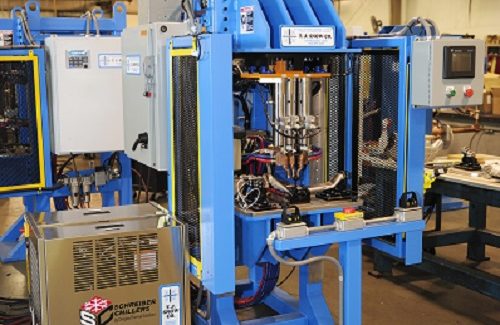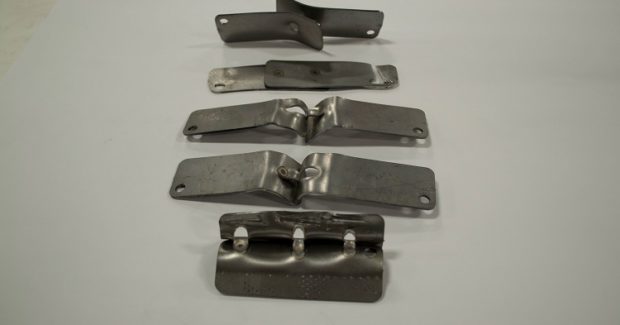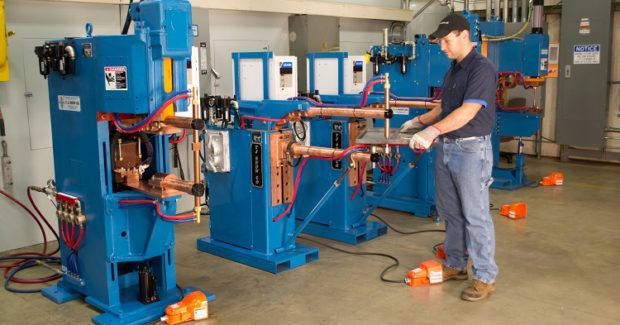The New Generation of Resistance Welding: Not Your Father’s Process
Resistance welding is a sub-specialty in the world of metal joining that was often ignored and taken for granted in the past, but not anymore: so many exciting new process technology developments are now taking place in this field that shops are trying to keep up so they can capitalize on the new business opportunities being created.
Posted: January 11, 2018
Although the Snow family has made their living in the field of welding for four generations, I never learned how to strike an arc. I’m sure that fact would greatly disappoint my grandfather, who was known as one of the best stick welders in Chattanooga back in his day, yet here I am writing on the subject of welding . . . more specifically, resistance welding – an often ignored sub-specialty in the world of metal joining. My 44-year career in the resistance welding field came about because my father was offered a job as a sales rep for resistance welding machines in the early 1950s, which eventually led him to start our family-owned business in 1963. Back then, he had to travel 11 southeastern states to find enough business to support our family. As a young salesman traveling the Southeast in the 1970s and 80s, I was often asked by customers “what’s new in resistance welding?” I usually had to answer “not much.” But that’s certainly not true today! All of that has changed with the influx of automotive manufacturing.
Although your car would fall apart without the use of resistance spot welding, the process has not received the recognition and respect it deserves until recently. More than 6,000 spot welds are used to manufacture the typical car body. The move to weight-saving high strength steel alloys (HSLA) has forced automotive welding engineers to pay closer attention to the process because these new alloys have a much narrower window of process variables that yield good joint strength. As many automotive components are being “light weighted,” more research than ever is being done to determine how to resistance weld these new materials with consistent success. Some auto makers are further reducing vehicle weight by substituting aluminum for steel, and resistance spot welding that material is a viable alternative to riveting and adhesives: for example, the Corvette plant in Bowling Green, KY, uses spot welding extensively for the car’s aluminum frame structure.
And if rivets are a must, such as for mixed-material assemblies, there’s a new process now being introduced called resistance spot riveting. Mid Frequency Direct Current (MFDC) resistance welding power supplies have largely replaced standard AC transformers in auto plants and are now also becoming more common in general industrial applications. Resistance welding with MFDC offers many advantages, including better weld quality at a reduced primary power demand. Significant advances have also been made in reducing the physical size and weight of the MFDC transformers that are integral to robot-manipulated spot welding guns. This advancement, in conjunction with electric servo-actuated force delivery systems, translates into smaller, faster robots and higher production line speeds.
Conversely, the increased use of aluminum alloys has challenged transformer manufacturers to develop larger MFDC power supplies that produce the high secondary amperage output required for resistance welding aluminum. In addition, newly-introduced “reversing DC” mid frequency transformer technology appears to be a breakthrough in improving spot welding electrode life, which has always been a challenge when welding aluminum. Capacitor discharge (CD) resistance welding power supplies, long popular in micro resistance welding applications, are now being offered in much larger output ratings. Press-type welding machines with CD power supplies and high force capabilities are often ideal for applications which benefit from a short burst of high amperage, such as resistance welding large nuts, studs and ring projections.
Important advances are also being made by manufacturers of resistance welding controls, the electronic “brains” of resistance welding machines. Due to today’s faster processing speeds, some advanced controls now have the ability to monitor several variables, such as nugget expansion, and compensate for variances on the fly. Also, new welding controls and guns are helping to meet the challenges of welding aluminum by applying and monitoring forging force. The ultimate goal is for all components of a resistance welding machine to work in harmony to monitor and adjust the process and hopefully “guarantee” good quality welds. Manufacturers of copper-based spot welding electrodes continue to offer new alloys designed to extend the time between weld face re-dressing, especially when welding coated steel and aluminum, and GM has patented a new ringed weld face design for spot welding aluminum.
All of these new developments mean that shops seeking to produce top quality resistance welded products should keep their engineers and set-up personnel up to date about the process, which has often been taken for granted in the past.
The American Welding Society (AWS; Miami, FL) currently offers two avenues for learning about resistance welding. The first is an online course available at www.awslearning.org. Additionally, each November during the FABTECH trade show, the Resistance Welding Manufacturing Alliance (RWMA; Miami, FL) a standing committee of AWS, offers their popular two-day course taught by subject matter experts from the resistance welding industry. Furthermore, the final version of the new AWS Certified Resistance Welding Technician (CRWT) exam will hopefully be rolled out within the next year. Once in place, it is anticipated that a CRWT exam-prep course will also be offered. The CRWT certification will be an important part of educating today’s workforce as manufacturers make sure they have qualified personnel on staff who can select the right welder and control and optimize the machine’s settings for a particular application.
Although resistance welding was invented over 125 years ago, the process is still pertinent and its use is growing in many industries. Of course, it never hurts that it remains the strongest, fastest, least expensive and most reliable metal joining method for many applications. The process remains basically the same as when I sold my first spot welder in 1973 – it’s robust, reliable and cost-effective – and improvements in modern resistance welding technology are exciting and promise a tremendous return on investment. And today, in stark contrast to the early years of my career, when I’m asked about what’s new in the resistance welding field, I now respond, “How much time do you have?”














